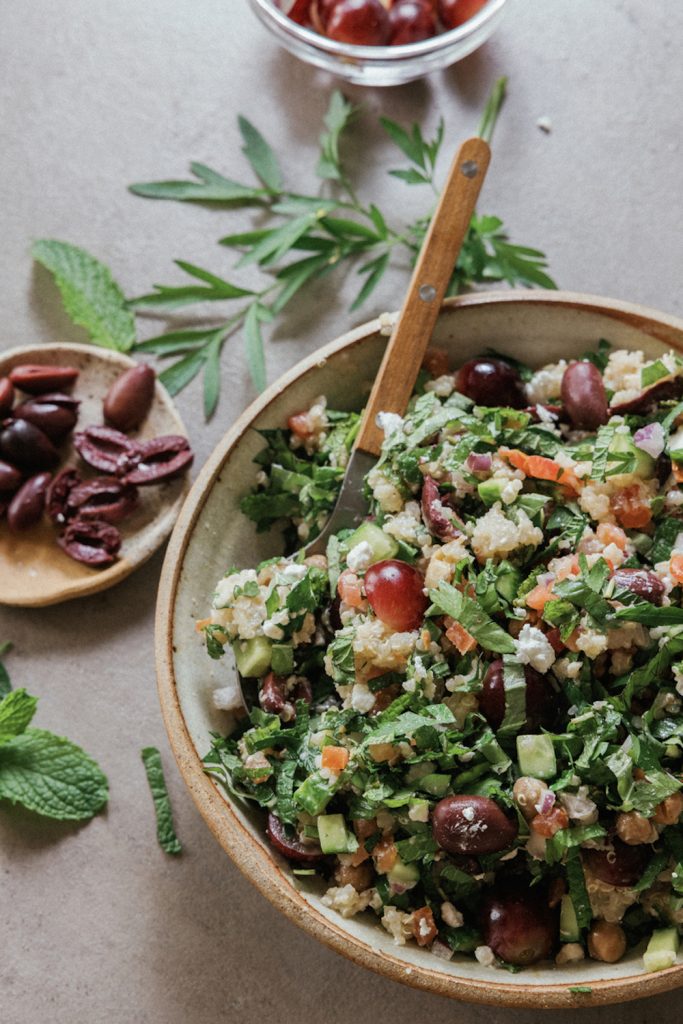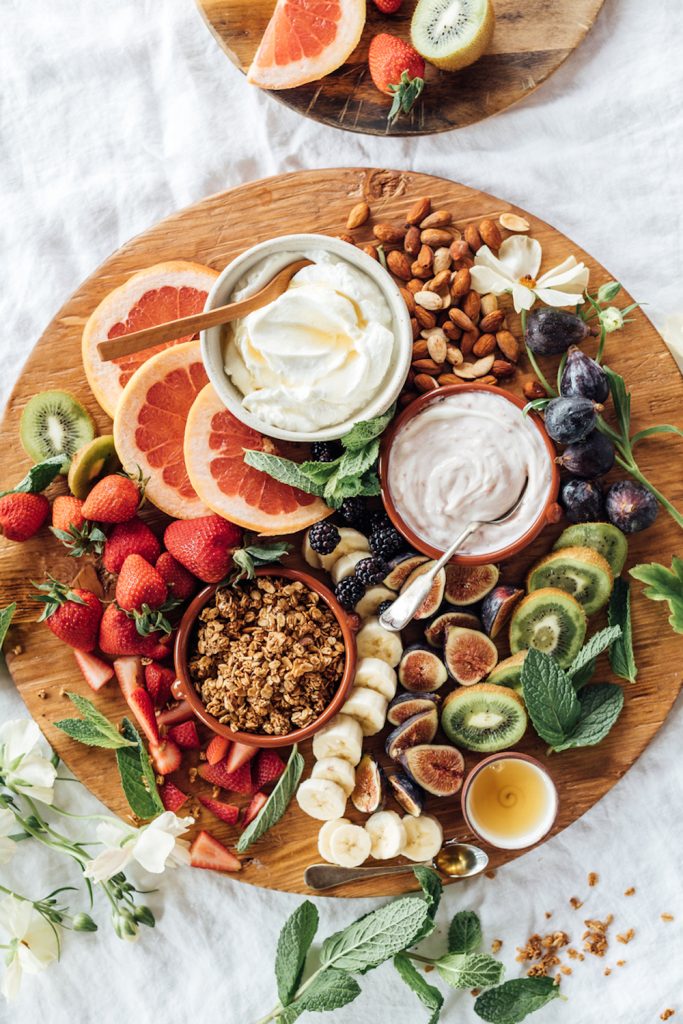It might be time to reach for an extra serving of greens, top your breakfast with berries, or dust off your blender. Most Americans aren’t getting enough fiber. As in, less than 5%. We’re insanely deficient (and experts are concerned). While this is shocking, it isn’t totally surprising. After all, the Standard American Diet is practically devoid of fiber. We obsess about carbs and protein, but we neglect fiber’s tiny but mighty impact. And thus, we’re overfed but undernourished. Without further ado, let’s break down what fiber is and the best high-fiber foods that help you get your fill.
Featured image by Michelle Nash.

What is fiber?
Fiber is a type of carbohydrate. It includes a broad spectrum of plant-based material (polysaccharides, pectin, guar gum, etc.) that the body can’t digest. Though most carbohydrates are broken down into sugar molecules, fiber is an outlier. Instead, fiber passes through the body undigested. It comes along for the ride—but this is a good thing! The fact that it isn’t digested is precisely why it’s so important. Fiber helps minimize constipation, regulates hunger cues, keeps blood sugar in check, slows glucose absorption, promotes heart health, and more. The FDA has a helpful, easy-to-digest guide on fiber here.


Soluble Fiber vs. Insoluble Fiber
There are two types of fiber. Both are essential, but each plays a different part in our health.
Soluble Fiber
Fiber that dissolves in water. Soluble fiber is derived from gums and pectins. It transforms into a thick, gelatinous gel when it dissolves in water. This gel helps lower cholesterol levels, especially LDL. Soluble fiber also helps lower glucose levels. It can be found in chia seeds, beans, fruit, carrots, oats, and more.
Insoluble Fiber
Fiber that doesn’t dissolve in water. Insoluble fiber helps to prevent constipation and keep things moving. Insoluble fiber is found in whole wheat flour, cauliflower, almonds, and potatoes.


Sources of Fiber
Fiber is mainly found in fruits, veggies, nuts, seeds, grains, and legumes. A good rule of thumb: whole foods—rich in color—are often high in fiber. Just another reason to eat the rainbow!
Cooked or raw, produce is an incredible source of fiber. However, studies show that for the highest fiber retention, eat your vegetables raw (or as close to raw) as possible. Cooking your veggies, through boiling, roasting, etc., can reduce the fiber by almost half. This is helpful if you’re new to eating fiber! Eventually, the biggest bang for your nutritional buck is to load up on mostly raw veg. (An apple a day…) By trial and error, you’ll find what works best for your body.
The Best High-Fiber Foods
Before we dive into high-fiber diet benefits, let’s look at some of the best bang-for-your-buck, high-fiber foods. For context, here’s a short list of foods that each offer a good source of fiber, complete with their approximate fiber content:
- One cup edamame: 18 grams
- One cup lentils: 16 grams
- One cup black beans: 15 grams
- One cup garbanzo beans: 12 grams
- Two tablespoons chia seeds: 10 grams
- One cup raspberries: 8 grams
- Half cup raw pistachios: 7 grams
- One persimmon: 6 grams
- One cup broccoli: 5 grams
- Half cup avocado: 5 grams


Why Americans Don’t Get Enough Fiber
When we talk about the pitfalls of the American diet, we tend to focus on our excessive amounts of processed sugar, table salt, and nutrient-devoid calories. Thus, we neglect to talk about fiber. There’s a nuance to its absence, but it mostly comes down to what we’re exposed to. The traditional American diet lacks fiber. Plus, what we’re offered at gas stations and fast food joints doesn’t make it any easier. We’ve wedged ourselves into the fiber gap.
Consider this list of low-fiber foods. How many of these options do we often associate with the standard American diet?
- Refined carbohydrates, like white flour pancakes, bagels, bread, pasta, and white rice.
- Animal protein.
- Dairy products.
- Low-fiber packaged goods, like cereal, chips, crackers, and granola bars.
- Most desserts, like traditional cookies, doughnuts, and cake.
- Sodas and other sugar-sweetened beverages.
Centuries ago, it wasn’t this way. The human species has traditionally evolved to eat fiber—a lot of it. Long before we learned to domesticate animals, we subsisted on mainly fiber-heavy fruits, roots, shoots, nuts, and seeds.


How much fiber do you need every day?
It’s up for debate. However, growing research shows that the official recommendations (less than 30 grams/day) may be lower than we really need for optimal health. What we actually need may be 50 grams/day (or more). Currently, the average American consumes 10-15 grams of fiber per day—nowhere near the mark. Let these stats empower you to add more fiber, stat.
The Link Between a Low-Fiber Diet and Disease
Yes. A lack of fiber can cause more than just constipation. In fact, it can elicit a slew of unwanted diseases (and even cancer). A lack of fiber can mean an unhealthy digestive system, which can lead to both short and long-term health complications. Low-fiber diets have been linked to everything from colon cancer to unhealthy cholesterol levels, a suppressed immune system, and obesity.


How to Slowly Eat More Fiber
There’s no need to do a complete detox—unless that speaks to you, of course! Instead, consider the notion of “crowding out.” The more fiber-rich ingredients you add to your plate, the more you’ll naturally crowd out more processed, nutrient-devoid foods.
Take advantage of meal prep
Begin meal prepping more plant-based foods. You’ll be much more likely to reach for foods with fiber when they’re ready to go (and easy to see). Take a peek at these high-fiber recipes for inspo.
Start slow
Rather than add high-fiber foods all at once, add 1-2 servings a day to your regular diet. Do this for a week, let your body adjust, then add another serving the following week. This can look like adding salads alongside your main course or opting for whole grains like barley, oatmeal, and brown rice. All of these alternatives are great sources of fiber and require little change to your habits.
Consider simple swaps
For example, opt for fiber-rich foods such as your regular bowl of cereal for high-fiber cereal, white pasta for 100% whole wheat pasta, berries instead of a banana, and a high-fiber protein bar instead of your usual grab-and-go snack.
Get creative
Food is fun! Enjoy an alternative weekend breakfast, like this beautiful (and functional) breakfast board. Or, try one of our many favorite soups to cozy up with. Eating more fiber doesn’t require pounding wheat bran.


The Benefits of High-Fiber Foods
They’re a dime a dozen. Eating more fiber improves digestion, maintains bowel health (lowering your risk of hemorrhoids, for example), lowers cholesterol levels, controls blood sugar levels, aids in achieving a healthy weight, and promotes longevity.
- Helps control blood sugar levels. In people with diabetes, fiber—particularly soluble fiber—can slow the absorption of sugar and help improve blood sugar levels. A healthy diet that includes insoluble fiber may also reduce the risk of developing type 2 diabetes.
- Aids in achieving a healthy weight. High-fiber foods tend to be more filling than low-fiber foods, so you’re likely to eat less and stay satisfied longer. And high-fiber foods tend to take longer to eat and to be less “energy dense,” which means they have fewer calories for the same volume of food.
- Helps you live longer. Studies suggest that increasing your dietary fiber intake—especially cereal fiber—is associated with a reduced risk of dying from cardiovascular disease and all cancers.
Chronic Constipation Relief
According to this article, prioritizing high-fiber foods in your diet significantly outperformed placebo for chronic constipation relief. Said differently: fiber keeps everything moving. And who doesn’t want to be regular? Dietary fiber softens your stools, making them easier to pass.
Gut Health
We have trillions of bacteria living in—and around—the human digestive tract. They need fiber! Bacteria feed off it. When there’s no fiber to eat, some forms of gut bacteria turn to the lining that protects the colon, which is not good. Basically, fiber keeps pro-inflammatory cells in check, improving overall gut health.
Disease Prevention
Studies have found that a high-fiber diet likely lowers the risk of colorectal cancer. In addition to helping prevent other diseases, fiber is key for heart health. Soluble fiber may aid in lowering low-density lipoprotein (LDL), or “bad,” cholesterol levels. Studies also have shown that high-fiber foods may have other heart-health benefits, such as reducing blood pressure and inflammation.
Healthier Body Weight
Fiber promotes a feeling of fullness more effectively than low-fiber and/or processed foods. In turn, it’s shown in research to support weight loss. This is a win-win, since increasing fiber intake will naturally encourage swapping out less healthy foods for natural, plant-based alternatives. While weight loss isn’t the primary objective of a high-fiber diet, most people end up losing a small (or moderate) amount of weight after upping their fiber consumption.
Improve Insulin Sensitivity
Tied with heart disease prevention, fiber helps stave off insulin resistance. It’s estimated that 88% of Americans are metabolically unhealthy. Fiber can reverse these stats tremendously. Time and time again, fiber has been proven to effectively keep blood sugar levels lower throughout the day. In essence, fiber “waters down” sugars, forcing them to take longer to absorb into the bloodstream.





